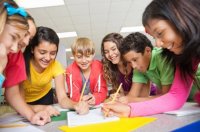Creating a Positive Climate and Culture: How Inclusive Schools Promote SEL
In a recent blog, I interviewed Dr. Brad Lerman about the Inclusive Schools Climate Initiative (ISCI), which he directs. Here, I share with you examples of some specific ways that several New Jersey schools have used SEL-related approaches to foster best practices for school-wide inclusion and the creation of norms of acceptance and support.
1. Brigantine North Middle School, Brigantine, NJ: St. Baldrick's Day is a community and school-wide event and fundraiser for childhood cancer. Considerable preparations are undertaken leading up to the event, requiring use of many SEL skills. Activities include a lip synch contest, an eating contest, and a "baldmitton" competition. Fire fighters and police join students and school staff in raising money to sponsor them having their heads shaved.
2. Thomas Sharp Elementary School, Collingswood, NJ: Climate survey data suggested students lacked Disabilities Awareness, and a program was created for that purpose. Kicked off program with an assembly. Embedded in regular class read-alouds, teachers included books about various disabilities. The author of Keep Your Ear on the Ball came to classes and discussed with students the impact of having a blind student in her classroom.
3. Memorial and Thomas Jefferson Middle Schools, Fair Lawn, NJ: Throughout the school year, students with autism and Down's Syndrome are pen pals with students who are English language learners. Their correspondence builds language skills, awareness of cultural and other differences, and culminates in a meeting in May. General education and ELL students work together with special needs students across the district on science lab projects, written pen pal letters, and reading to one another.
4. Mendham Township Middle School, Mendham, NJ: Disabilities awareness is promoted by having each grade level read a specific novel focused on a child with so-called "visible" and "invisible" disabilities. Advisory classes reinforce the messages in the novels, providing time for students to reflect on the characters' strengths and difficulties and how they coped.
5. Livingston Park Elementary and Linwood Middle Schools, North Brunswick, NJ: Livingston Park has had in place an award-winning SEL program, Project Harmony, which exposes all students to peace education, conflict resolution, and prejudice reduction skills. A Family Circles program brings cross- sections of students and teachers together throughout the year on joint projects to create a better sense of belonging in the school. There is also a strong fifth grade leadership program and Student Council that includes students with disabilities. Yoga in classrooms also helps reduce tension and provides regular opportunities for stress relief. All fifth-graders participate in a disabilities awareness program with Linwood staff and special education students involving experiences at five "stations": muscular mobile disability, visual process and learning disorders, dyslexia, blindness/visual impairment, and hearing impairment. For example, students must stack pennies and color precisely with a sock on their hand. At the end of the program, fifth-graders get a bookmark with the slogan, "Abilities Link Us Together" and share what they learned with their fifth grade teachers.
In Your Schools and Classrooms...
These examples are inspiring and should prompt similar ideas that you can adapt. It must be noted that the ISCI does not have as much traction in larger schools and in high schools. And a number of schools in the ISCI still focus on limited projects, such as a "day" or a "week" or two devoted to disabilities in some way, when we know that continuity is essential and that the cliché, "slow and steady wins the race," truly applies here. But they are aware of this and will build on these promising beginnings. And speaking of races, Project UNIFY is a growing program linked with Special Olympics that has excellent activities for all schools designed to bring youth with intellectual and other disabilities together with their peers in meaningful ways, particularly around sports. The website includes detailed information and sample materials.
Bottom line: When done properly and in ongoing ways, inclusion benefits all students including the development of SEL skills. Any school can adapt the models illustrated here without disrupting (indeed, often enhancing), usual academic and school routines.
